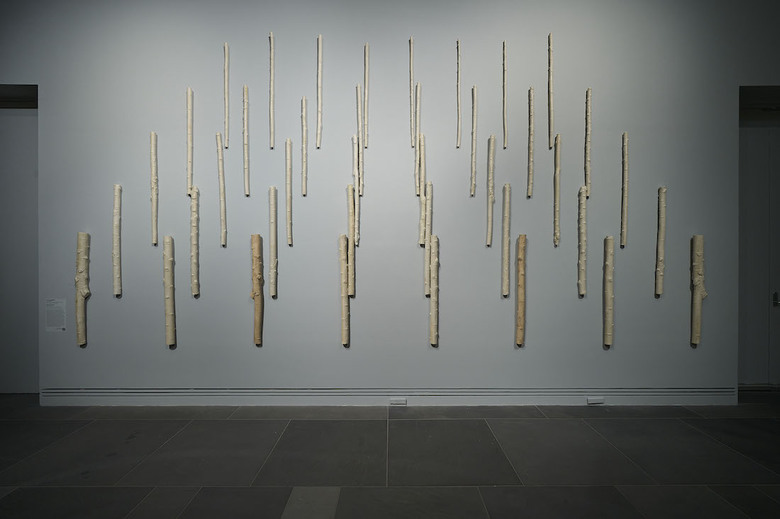
Yasmin Smith, Terra Dei Fuochi,
2021, poplar wood ash glaze on Limoges porcelain, 40 pieces, overall installed dimension: 310 x 622 x 5cm (376 cm from floor to top of work), TCG22427
(photo: Sam Roberts @samrophoto)
Terra Dei Fuochi was produced in the area of Campania in Southern Italy that spans over 1,000 square kilometers, that has been subjected to criminal waste disposal since the 1980s and takes its name from the illegal fires lit to disposed of surplus waste that cannot be buried underground. For the project, Smith collaborated with Massimo Fagnano, Professor of Agronomy at the University of Napoli Federico II, to collect poplar wood from the open-air laboratory of San Giuseppiello in Giugliano, located 20 km north of Naples. The tree species harvested at the laboratory are employed in a process of phytoremediation, in which trees absorb heavy metals from the contaminated soil (in the case of Smith’s installation, chromium and zinc from tannery waste). Fagnano has surprisingly found that the mineral-rich local volcanic soil acts to neutralize toxicity by changing its atomic makeup, so that contaminating elements are held in another form in the soil, an extraordinary mechanism of self-healing system in local ecologies. As noted by the artist, ‘Biological and phytoremediation show us that the soil and plants have the incredible ability to rehabilitate from destructive activities performed by some humans. Indeed, the plants are performing the task of rescuing the site from further degradation and returning it to safe use for humans and other beings.’
Artist statement
Terra Dei Fuochi is a part of my ongoing research practice which seeks to produce an archive of the aesthetic manifestation of combined environmental and human history through the creation of ceramic forms and ash-glazes that are derived from plants. Since 2014 I have been undertaking these research projects throughout Australia, in China, France and now Italy. Each project I undertake is comparable to the next because the parameters I use for the glazes and ceramic process are always the same. The same glaze recipe, the same firing temperature. I apply the ash-glaze to the cast forms of the specific corresponding plant that I have used in order to bring to the outside and make visible that which we usually cannot see locked up inside the plant’s bodies. Through a collaboration with the Professor of Agronomy Massimo Fagnano, I was able to access poplar tree trunks from a phytoremediation plantation set up by the Professor as a part of the LIFE- Ecoremed Program and the University of Napoli Frederico II. The plantation is an open-air laboratory called San Giuseppiello in Giugliano 30 mins north of Napoli city. The work expresses an environmental narrative as it is recorded by the trees that have grown in that location. It also shows the ability of nonhuman technology: bio-accumulation and phytoremediation have shown us that soil, trees, funguses micro organisms, have this incredible ability to actually rehabilitate themselves, even in situations where some humans have caused devastating environmental damage.






